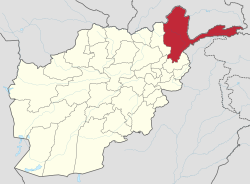2012 Afghanistan avalanches
On March 4, 2012, at least three avalanches struck the Badakhshan province of northeastern Afghanistan.[1] One of those avalanches destroyed a small village of about 200 people. The name of the village is uncertain; some sources call it Dasty and locate it in Darzab District,[1] and others call it Sherin Nazim and locate it in Shekay District.[2][3] Two other villages were affected by the avalanche.[3] At least 50 people were killed in the disaster.[4]
Most buildings in the village, which was home to 24 families, were completely engulfed in snow.[2][4] As of March 7, 50 people had been confirmed dead, with only 7 known survivors.[5] Of the survivors, three were away fetching water at the time of the avalanche and thus survived uninjured.[5] Seven people were found alive in the village, but three perished due to lack of medical attention.[5] The remaining survivors were taken to the nearest hospital, in Tajikistan, for treatment.[2] It is believed that most or all of the town's remaining residents are dead.[5][6]
The village affected by the avalanches was so remote that it took a full day for news of the disaster to reach Fayzabad, the province's capital.[2] There are no roads in the affected area and people there generally travel on foot or horseback.[2] Nearby villages offered what help they could, but outside rescue workers did not arrive on the scene until March 6 or 7, walking two days to get there.[2][5] People from Darwaz District and twenty-five aid workers from Tajikistan were the first outside rescuers to arrive.[4][5] Their progress toward the affected area was slowed by another avalanche.[4] An aircraft carrying aid workers and journalists was unable to reach the region due to bad weather, while two Afghan Army helicopters managed to bring some aid workers into the region.[4] Governor Shah Waliullah Adeeb tried to visit the disaster area himself, but was caught in yet another avalanche on the way and had to be rescued by helicopter.[2]
Conditions remained extremely hazardous in the immediate aftermath of the disaster.[2] The risk of melting snow causing widespread flooding continues to threaten a larger-scale disaster for the Northern Afghanistan.[4] A flood could spread disease and ruin farm land.[4]
Cause and aftermath
Several days of heavy snowfall were followed by a rise in temperature, created ideal conditions for avalanches.[3] This was part of a larger pattern of a harshest winter in 15 years.[6] The New York Times cited the government being "woefully unprepared" to deal with natural disasters as a contributing factor.[4] In recent years, snow has regularly cut off remote villages, making it difficult to deliver medical supplies to where they are needed. As a result, pneumonia rates have risen.[4] More than 200 people have been killed by avalanches in Afghanistan this winter, including at least 80 in the Badakhshan province.[1][3]
The United Nations had flown in tons of food and medical supplies the previous fall as part of a strategy for coping with the region's harsh winters. The aid did not appear to have helped.[4] Three days after the disaster Fawzia Koofi, a member of parliament, remarked "so far there is no medicine, no food, no rescue yet in the area."[4] Koofi continued by saying there should have been adequate supplies in the area and that government needed to explain how the system failed its people.[4]
The United States Embassy in Kabul sent its condolences and arranged for supplies to be transferred to the affected region.[1]
References
- Shah, Amir (March 7, 2012). "47 dead in Afghanistan avalanche". Google. Associated Press. Retrieved March 8, 2012.
- Alissa J. Rubin (March 6, 2012). "Avalanche and Attacks Add to Woes of Afghans". New York Times. Retrieved March 8, 2012.
- "Search for survivors after Afghan avalanches kill 42". Google. Agence France-Presse. March 7, 2012. Retrieved March 8, 2012.
- Bowley, Graham (March 7, 2012). "Avalanche Exposes Afghans' Vulnerability to Vagaries of Climate and of Aid". New York Times. Retrieved March 7, 2012.
- Amir Shah (March 8, 2012). "Avalanche buries Afghanistan village". Sky News. AP. Retrieved March 8, 2012.
- "Avalanche kills 37 in Afghan village". The News. AFP. March 7, 2012. Retrieved March 8, 2012.
